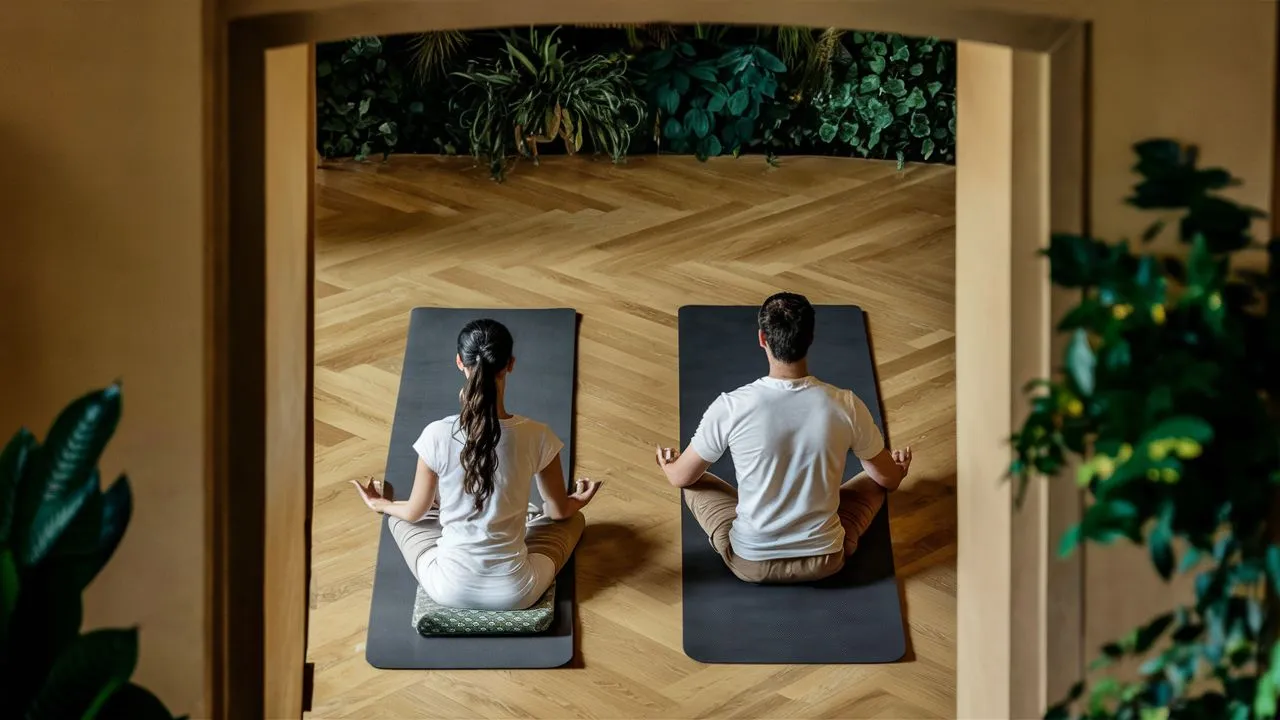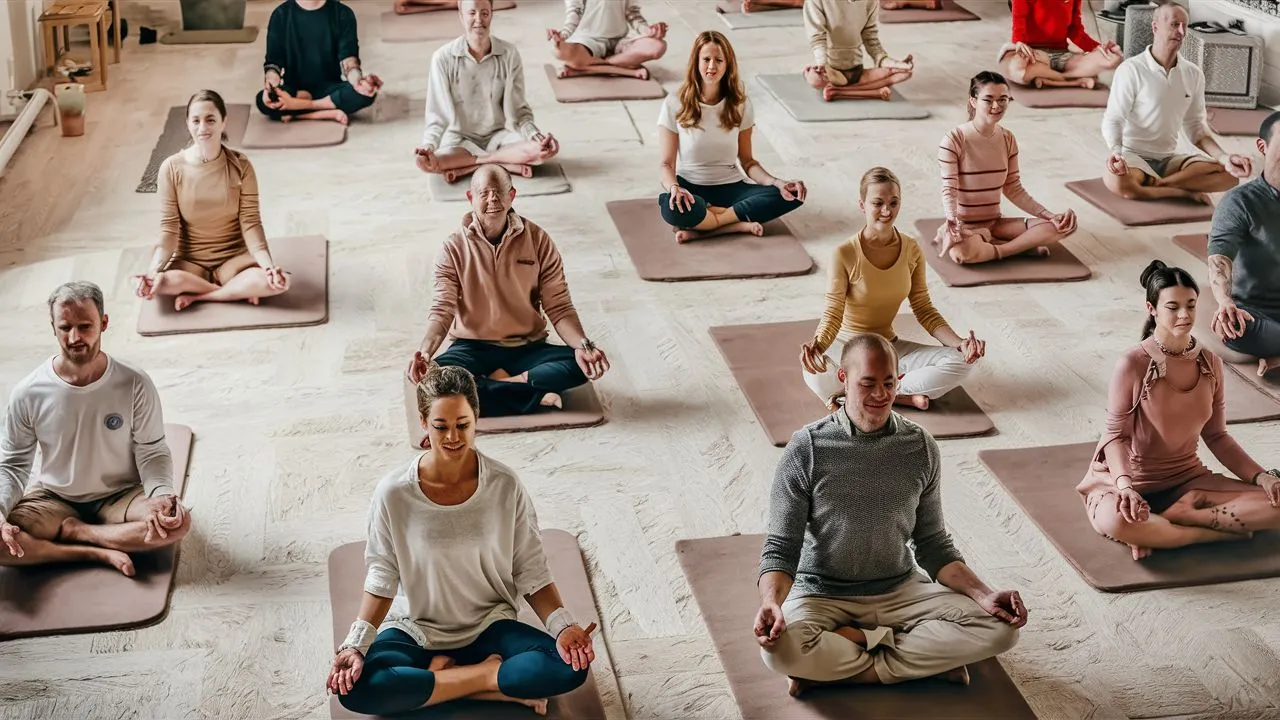Firstly find a quiet and comfortable spot. You can sit on the floor or a chair whatever feels good for you. Just make sure your back is straight but not too rigid. Imagine youre a tall tree rooted firmly to the ground.
Now close your eyes gently. Take a deep breath in through your nose and then slowly breathe out through your mouth. Do this a few times to relax your body and mind.
Next let your hands rest comfortably on your lap or knees. You can place them palms up or palms down whatever feels natural.
Now focus on your breath. Feel the air flowing in and out of your nostrils. Notice how your chest rises and falls with each breath. If your mind starts to wander gently bring it back to your breath.
Try to let go of any tension or stress you may be feeling. Just be present in the moment fully aware of your breath and your body.
You can meditate for as long as you like whether its just a few minutes or longer. When youre ready to finish slowly open your eyes and take a moment to notice how you feel.
Thats it Sitting for meditation is all about finding a peaceful space tuning into your breath and being present in the moment. Practice regularly and youll soon reap the benefits of a calm and centered mind.
Benefits of Meditation And Manifestation
| Benefit | Meditation | Manifestation |
|---|---|---|
| Inner Peace | Reduces stress and anxiety | Cultivates a positive outlook |
| Focus and Clarity | Improves concentration and attention span | Brings awareness to goals and desires |
| Self-Awareness | Increases understanding of thoughts and emotions | Identifies limiting beliefs |
| Emotional Regulation | Develops healthy coping mechanisms for negativity | Promotes feelings of gratitude and abundance |
| Improved Well-being | Boosts overall mood and sense of calm | Encourages a growth mindset |
| Increased Focus | Trains the mind to stay present in the moment | Allows for visualization of desired outcomes |
How to sit guidelines for the lower body
- Keep Knees Lower: Ensure your knees are lower than your hips for stability and to avoid strain.
- Comfortable Position: Find a position where you feel stable and relaxed. You can adjust your legs to find the most comfortable posture for you.
- Foot Placement: Keep your feet grounded and relaxed. They can be tucked under your legs or flat on the floor, depending on your preference.
- Support: If needed, use a cushion or folded blanket under your buttocks to elevate your hips slightly and make sitting more comfortable.
That’s it! These simple guidelines will help you find a comfortable and stable sitting position for your meditation practice.
5 seated positions meditation
Sure thing Here are five seated meditation positions explained in simple terms
- CrossLegged Easy Pose Sit on the floor or a cushion with your legs crossed. Keep your spine straight but relaxed. Rest your hands on your knees or in your lap.
- Half Lotus Start by sitting on the floor or cushion with one foot resting on the opposite thigh. Keep the other foot underneath the opposite thigh. Maintain a straight spine and relaxed shoulders.
- Full Lotus Similar to the half lotus but both feet are placed on opposite thighs. This position requires flexibility in the hips and knees. Keep your spine straight and shoulders relaxed.
- Burmese Position Sit on the floor or cushion with both legs crossed in front of you. Keep your knees and feet touching the ground. Maintain a straight spine and relaxed posture.
- Seiza Position Kneel on the floor or cushion with your buttocks resting on your heels. Keep your spine straight and hands resting on your thighs or in your lap. You can use a cushion or bench between your legs for support if needed.
Choose a position that feels comfortable for you and remember to maintain good posture while keeping your body relaxed. Happy meditating

Sitting Posture Guidelines for Meditation
CrossLegged
Sit on the floor or a cushion with your legs crossed. Keep your back straight but relaxed. You can put your hands on your knees or in your lap. Just find a comfy spot and sit up nice and straight. Thats the easy pose for meditation
Half Lotus
Sit down on the floor or a cushion. Cross one leg over the opposite thigh kinda like making a 4 shape with your legs. Keep your back straight and relax your shoulders. Thats the half lotus Just find your balance and chill out.
Full Lotus
Sit on the floor or a cushion. Cross both legs so that each foot rests on the opposite thigh. Its like making two 4 shapes with your legs. Keep your back straight and shoulders relaxed. Thats the full lotus Just find your comfy spot and settle in for some peaceful meditation.
Burmese Position
Sit on the floor or a cushion. Cross your legs in front of you keeping your knees and feet touching the ground. Make sure your back is straight and your shoulders are relaxed. Thats the Burmese position Just find your cozy spot and get ready to meditate
Seiza Position
Kneel on the floor or a cushion with your buttocks resting on your heels. Keep your back straight and your hands resting on your thighs or in your lap. You can use a cushion or bench for support if needed. Thats the Seiza position Just find your comfortable spot and get ready to meditate.

How to sit for meditation using support
- ind a Comfortable Seat: Sit on the floor, a cushion, or a chair, whichever feels most comfortable for you.
- Use Support: If sitting on the floor, you can use a cushion, folded blanket, or yoga block to elevate your hips slightly and support your spine.
- Align Your Spine: Keep your back straight but not rigid. Imagine a string pulling you up from the crown of your head.
- Relax Your Shoulders: Let your shoulders drop down and away from your ears. This helps release tension in your upper body.
- Position Your Hands: Rest your hands on your knees or in your lap, palms facing up or down, whichever feels natural.
- Adjust as Needed: If you feel any discomfort during meditation, feel free to adjust your posture or support to find what works best for you.
That’s it! Using support can make sitting for meditation more comfortable and enjoyable. Experiment with different cushions or props until you find the perfect setup for your practice.
Sitting Posture Guidelines for Meditation
Certainly! Here are some frequently asked questions about sitting posture guidelines for meditation:
- What is the best posture for meditation?
- The best meditation posture is one that allows you to sit comfortably and maintain focus on your breath and practice. Here are some common seated positions to explore:
- Sitting in a Chair: This is an easy position that provides back support. Sit with a straight back, legs uncrossed, and feet flat on the floor. Use pillows if needed for lower back support.
- Easy Cross-Legged Pose (Sukhasana): A classic meditation pose where you sit with legs crossed in front of you. Add pillows or blankets under your knees if necessary.
- Legs Stretched Out: If cross-legged bothers your knees, stretch your legs out in front of you while maintaining an upright yet relaxed posture.
- The best meditation posture is one that allows you to sit comfortably and maintain focus on your breath and practice. Here are some common seated positions to explore:
- How should I align my spine during meditation?
- Regardless of the position, ensure your spine is aligned. Your head should be directly over your heart, and your center should be positioned over your hips. If sitting on the floor, use a rolled-up blanket or cushion for support
- What should I do with my arms and hands?
- Keep your arms parallel to your torso, with palms resting naturally on your thighs. This allows for stability and comfort during meditation.
- What about eye gaze and chin position?
- Gaze slightly downward, about 4 to 6 feet in front of you, or close your eyes. Tuck your chin slightly to align your cervical spine
Remember, the key is to find a posture that feels comfortable for you. Happy meditating.
Conclusion
In conclusion finding the right sitting posture for meditation is all about comfort and stability. Whether you choose to sit crosslegged in a chair or even stand or lie down the key is to keep your spine straight shoulders relaxed and body comfortable. Experiment with different positions to see what works best for you and remember that theres no onesizefitsall approach. The most important thing is to find a posture that allows you to relax and focus your mind during meditation. So take a seat find your balance and let your posture support you on your journey to inner peace and mindfulness.
Want to Know more about us:https://fiverblogs.com/

1 thought on “Sitting Posture Guidelines for Meditation”